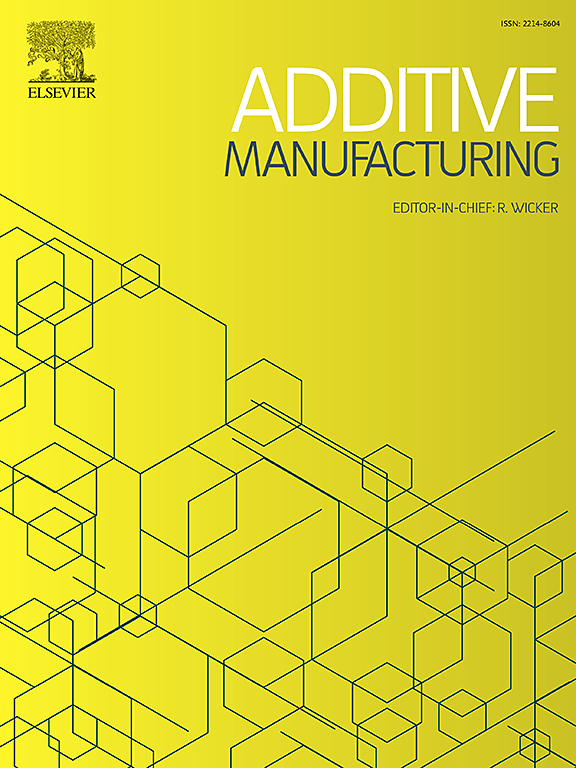AI for AM in zirconia ceramic vat photopolymerization: A machine learning approach to stabilising slurry suspension and maximizing dimensional accuracy of the 3D print process
IF 11.1
1区 工程技术
Q1 ENGINEERING, MANUFACTURING
引用次数: 0
Abstract
The stability of ceramic suspensions and the dimensional accuracy of green bodies are critical factors influencing both printing process and the quality of the final component. Therefore, assessing dispersant agents and stability is essential during the suspension development stage. A novel power-law-based stability assessment approach was developed and employed for evaluating dispersant performance. The conventional stability testing method is based on visual monitoring and requires prolonged durations, whereas the newly introduced technique demonstrated significantly greater accuracy within a much shorter timeframe, which is in complete accordance with the conventional stability testing methods. Consequently, among six dispersants examined, DisperBYK-145 was selected based on the results of both evaluation methods. Additionally, the dimensional errors of green-body zirconia ceramics were analysed considering printing parameters and slurry additives. Optimal parameters were determined as 5.5 mW/cm² light intensity, 0.1 wt% photoinitiator, and 4 wt% white pigment (TiO2) to minimise geometric errors. Given its significance, supervised machine learning algorithms were employed to predict dimensional errors based on the selected parameters. An artificial neural network model with 12 hidden nodes exhibited the best performance, aside from averaging-based ensembles. This study introduces a stability assessment method and machine learning models to predict the dimensional accuracy of zirconia ceramic suspensions in vat-photopolymerisation.
用于氧化锆陶瓷缸光聚合增材制造的人工智能:一种稳定浆液悬浮液和最大化3D打印过程尺寸精度的机器学习方法
陶瓷悬浮液的稳定性和坯体的尺寸精度是影响打印过程和最终部件质量的关键因素。因此,在悬浮液开发阶段,评估分散剂及其稳定性至关重要。提出了一种新的基于幂律的分散剂稳定性评价方法,并将其应用于分散剂性能评价。传统的稳定性测试方法基于视觉监测,需要长时间的持续时间,而新引入的技术在更短的时间内显示出更高的准确性,这与传统的稳定性测试方法完全一致。因此,在6种分散剂中,基于两种评价方法的结果,选择了DisperBYK-145。此外,还分析了考虑印刷参数和浆料添加剂的氧化锆绿体陶瓷尺寸误差。确定的最佳参数为5.5 mW/cm²光强、0.1 wt%光引发剂和4 wt%白色颜料(TiO2),以减小几何误差。鉴于其重要性,采用监督式机器学习算法根据所选参数预测尺寸误差。除了基于平均的集成外,具有12个隐藏节点的人工神经网络模型表现出最好的性能。本研究引入一种稳定性评估方法和机器学习模型来预测氧化锆陶瓷悬浮液在光聚合过程中的尺寸精度。
本文章由计算机程序翻译,如有差异,请以英文原文为准。
求助全文
约1分钟内获得全文
求助全文
来源期刊

Additive manufacturing
Materials Science-General Materials Science
CiteScore
19.80
自引率
12.70%
发文量
648
审稿时长
35 days
期刊介绍:
Additive Manufacturing stands as a peer-reviewed journal dedicated to delivering high-quality research papers and reviews in the field of additive manufacturing, serving both academia and industry leaders. The journal's objective is to recognize the innovative essence of additive manufacturing and its diverse applications, providing a comprehensive overview of current developments and future prospects.
The transformative potential of additive manufacturing technologies in product design and manufacturing is poised to disrupt traditional approaches. In response to this paradigm shift, a distinctive and comprehensive publication outlet was essential. Additive Manufacturing fulfills this need, offering a platform for engineers, materials scientists, and practitioners across academia and various industries to document and share innovations in these evolving technologies.
 求助内容:
求助内容: 应助结果提醒方式:
应助结果提醒方式:


